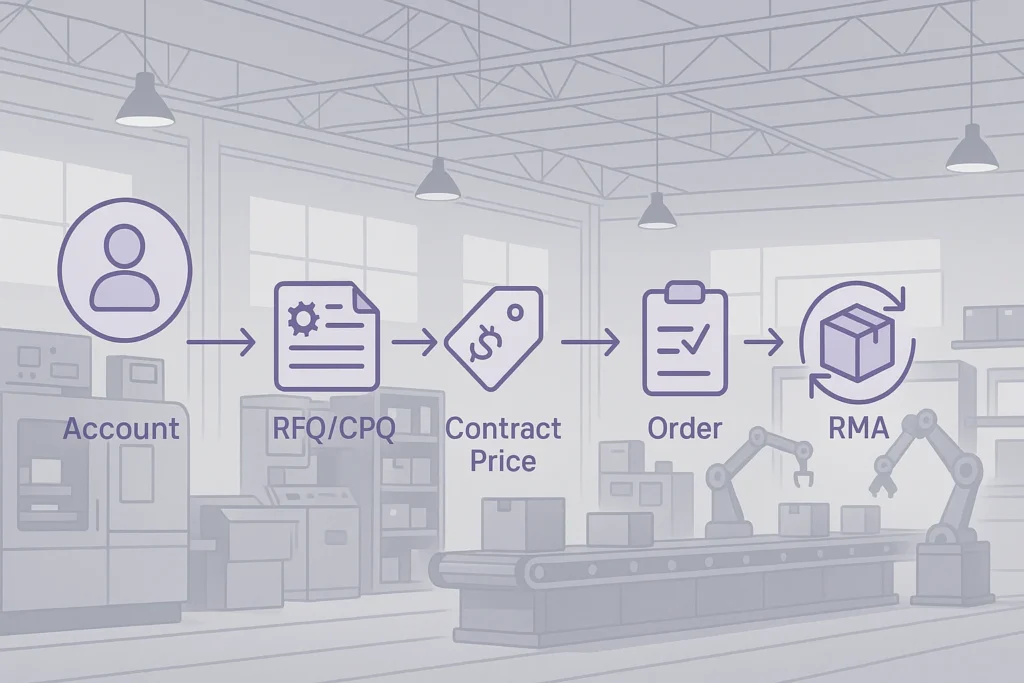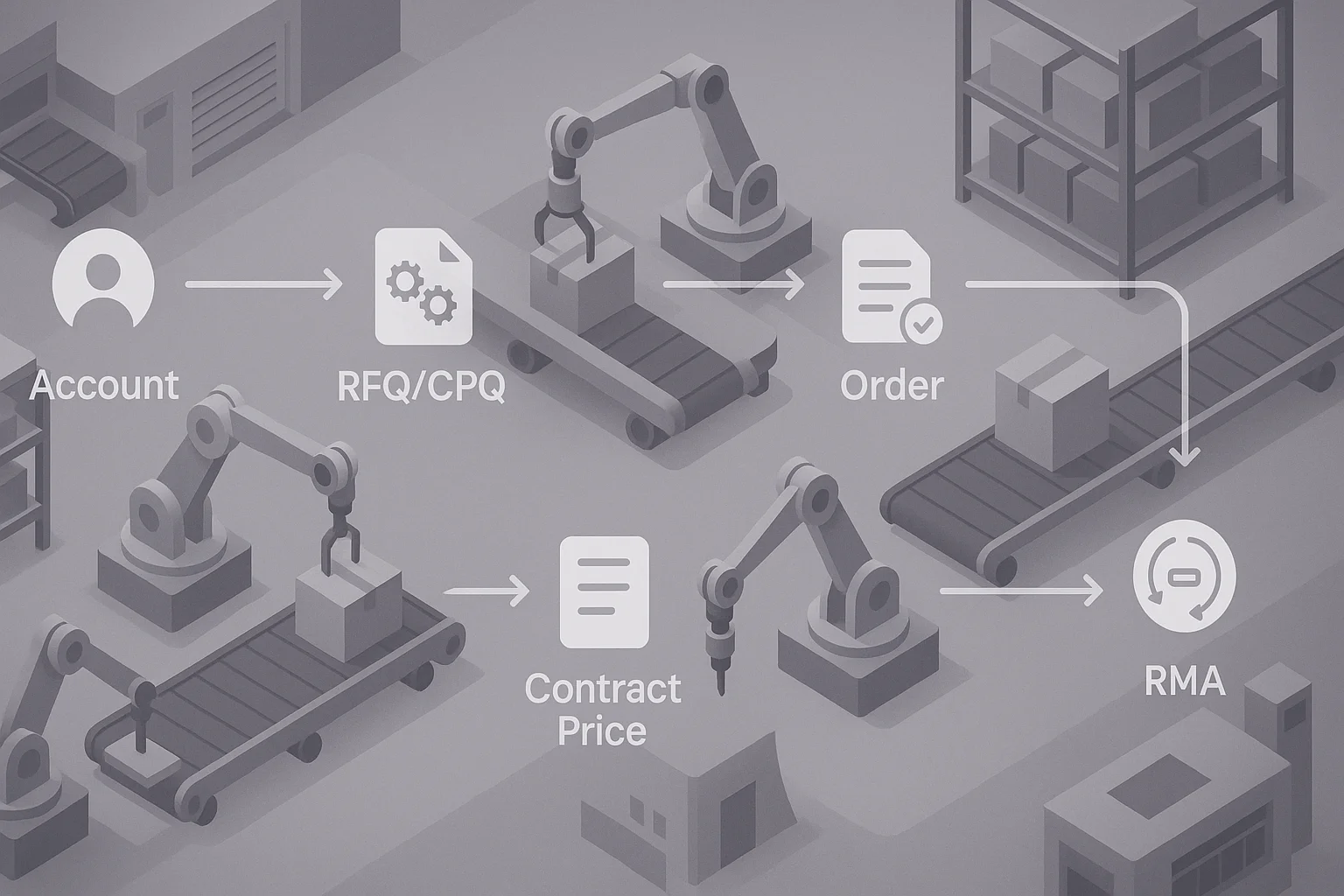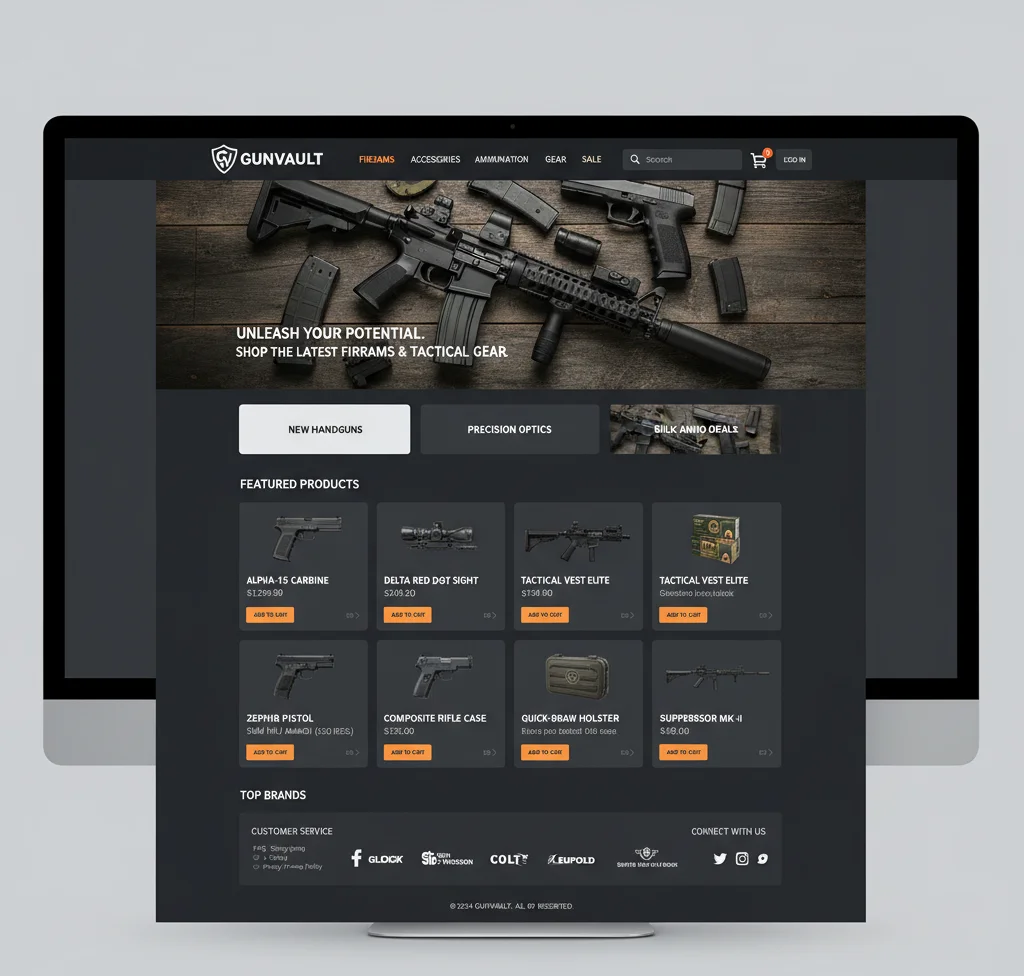M2B Commerce: What Manufacturers Need To Get Right
If you run a manufacturing organization, you already speak the language of purchase orders, credit limits, lead times, and contract pricing. “M2B” simply gives a direct name to the model you are trying to scale: a manufacturer selling to business buyers across dealers, distributors, integrators, and strategic accounts through a modern digital stack. Most vendors still call this B2B for manufacturers. The mechanics are the same. The difference is emphasis. In M2B, the manufacturer owns the catalog, the rules, and the data that drive the experience.
Why M2B is rising now
Buyers expect self-service and accuracy. Sales teams want clean data instead of stale spreadsheets. Finance needs price compliance. Partners want clarity on territories, deal registration, and who services what. The moment you connect a digital front door to your ERP and start honoring contract prices in real time, you are no longer running a brochure site. You are running an operating model.
Scenario 1: Direct-to-dealer without channel conflict
Picture a manufacturer of industrial pumps with a mature dealer network. Historically, every quote started with a call to inside sales. Quote creation lived in email threads. A dealer could not see inventory or lead times. Contract prices were handled in Excel and retyped into orders later.
In the M2B model, the dealer logs in to a branded portal and sees contract pricing sourced from the ERP. They configure a pump with validated options, submit an RFQ, and receive a system-generated quote that respects credit limits and tax rules. When the dealer accepts, the quote converts to an order and pushes to the ERP for fulfillment. Territories and house accounts are encoded as policy, so the portal routes the opportunity to the right partner. No conflict and no rekeying. Inside sales still plays a role, but as a coach and exception handler instead of a human API.
What changes for the business is not only speed. The quote to order time shortens, order accuracy improves, and disputes over pricing disappear because there is one source of truth.
Scenario 2: Complex configuration tied to real operations
Now consider a manufacturer of configurable enclosures. Options are not cosmetic. They change dimensions, materials, and lead times. Sales reps used to call engineering to validate feasibility. Delivery dates were guesses.
In an M2B flow, configuration rules live in a CPQ service that references the product master and routing data. When a buyer selects an option, the system recalculates the build path and updates availability. The quote the customer sees is not a best effort. It is grounded in manufacturing reality. If a combination is not allowed, it never appears. If a special approval is required, the workflow pulls in the right approver before a promise date leaves the screen.
Operations feels the benefit first. Fewer scrapped orders, fewer expedites, and production plans that match what was sold. Customers feel it next. Fewer surprises and a clear line of sight from configuration to delivery.
Scenario 3: Strategic accounts with negotiated terms
A global OEM buys from you across regions with a negotiated catalog and service credits. The rules are precise. The moment a buyer clicks “add to cart,” you need to honor those rules without creating a special project each time.
The M2B stack handles this through account hierarchies, role-based access, and contract catalogs. The OEM’s buyers see only what they are allowed to buy at the prices you negotiated. Approvals follow the OEM’s internal workflow. Budget drawdowns and service credits are visible in the portal. Your team is not building a one-off website for this account. You are configuring policy and data in a system designed to express those rules.
What the stack actually needs to do
A workable M2B platform is less about flashy storefronts and more about discipline. Corporate accounts need multiple buyers, budgets, and approvals. Contract pricing needs to be the default, not an exception. Quotes must convert to orders without manual re-entry. Bulk and repeat orders should be easy. Returns and warranties should follow a clear path. Every one of these motions should be reconciled against the ERP, because the ERP is where credit, inventory, tax, and fulfillment live.
When these flows are encoded, the organization stops chasing errors and starts moving volume. You are not “integrating a website.” You are building a controlled interface to core systems that customers and partners can trust.
The operating model behind the platform
Technology only delivers if the operating model supports it. We approach M2B in three moves.
First, establish a baseline with a health check. Map how quotes are created, how pricing is managed, where data originates, and where the handoffs fail. Tie every finding to a measurable outcome such as order accuracy or self-service adoption.
Second, set governance. Decide what gets built, in what order, who owns which metric, and how trade-offs are handled. Write the channel rules. Publish them. If a conflict occurs, point to the policy instead of the loudest voice.
Third, deliver through a PMO. Run a clear backlog, control scope, and instrument the flows. If quote to order time does not improve, fix that before adding new features. If dealers still call inside sales for basic status, improve the portal before launching a marketing campaign. The scoreboard drives the roadmap.
Measuring what matters
Executives do not need a dashboard with thirty charts. They need proof that the operating model is getting healthier. Track the time from RFQ to order. Track dealer self-service adoption. Track order accuracy and fill rate. Track margin by channel and compliance with contract pricing. Track uptime. These numbers tell you if the work is creating value or just generating activity.
Avoiding the common traps
Most programs stall for the same reasons. Pricing lives in spreadsheets that drift away from the ERP. Configuration logic sits in the heads of a few experts. Integrations sync partial data on a schedule and create timing errors. The portal does not cover returns or warranty, so buyers call anyway. None of these are technical mysteries. They are signs that rules were never made explicit or that systems were connected without a shared data contract.
The fix is straightforward. Move rules into systems. Align product and pricing masters. Define the data contracts between commerce, CPQ, ERP, and CRM. Test with real accounts and real orders before you scale. Publish the channel policy and enforce it in software.
How Metrotechs helps
Metrotechs focuses on manufacturer-led B2B and the outcomes leadership cares about. We start with a Commerce Health Check to surface issues and produce a plan tied to measurable targets. We build a Platform and Data Architecture Strategy that is vendor neutral and pragmatic. We provide Performance Governance, which is PMO discipline that keeps your roadmap, budget, and quality in bounds while we track the KPIs that matter.
The principle is simple. Own your workflows. Run on your cloud. Keep your data. When those three are true, M2B stops being a buzzword and starts looking like an advantage.
Where to begin
Pick one product line and one dealer or account. Run a short pilot that covers the full journey from configuration to invoice. Prove that the quote is accurate, the order is synced, the delivery date is real, and the buyer can self-serve the basics. Measure the results. Then expand.
M2B does not require a reinvention of your business. It requires clarity about who the seller is, what the rules are, and where the truth lives in your systems. Get those right and scale follows.





